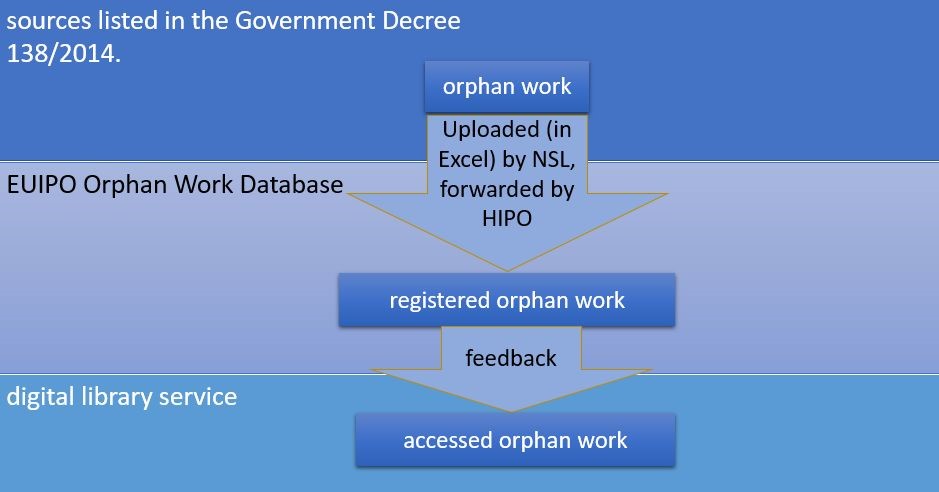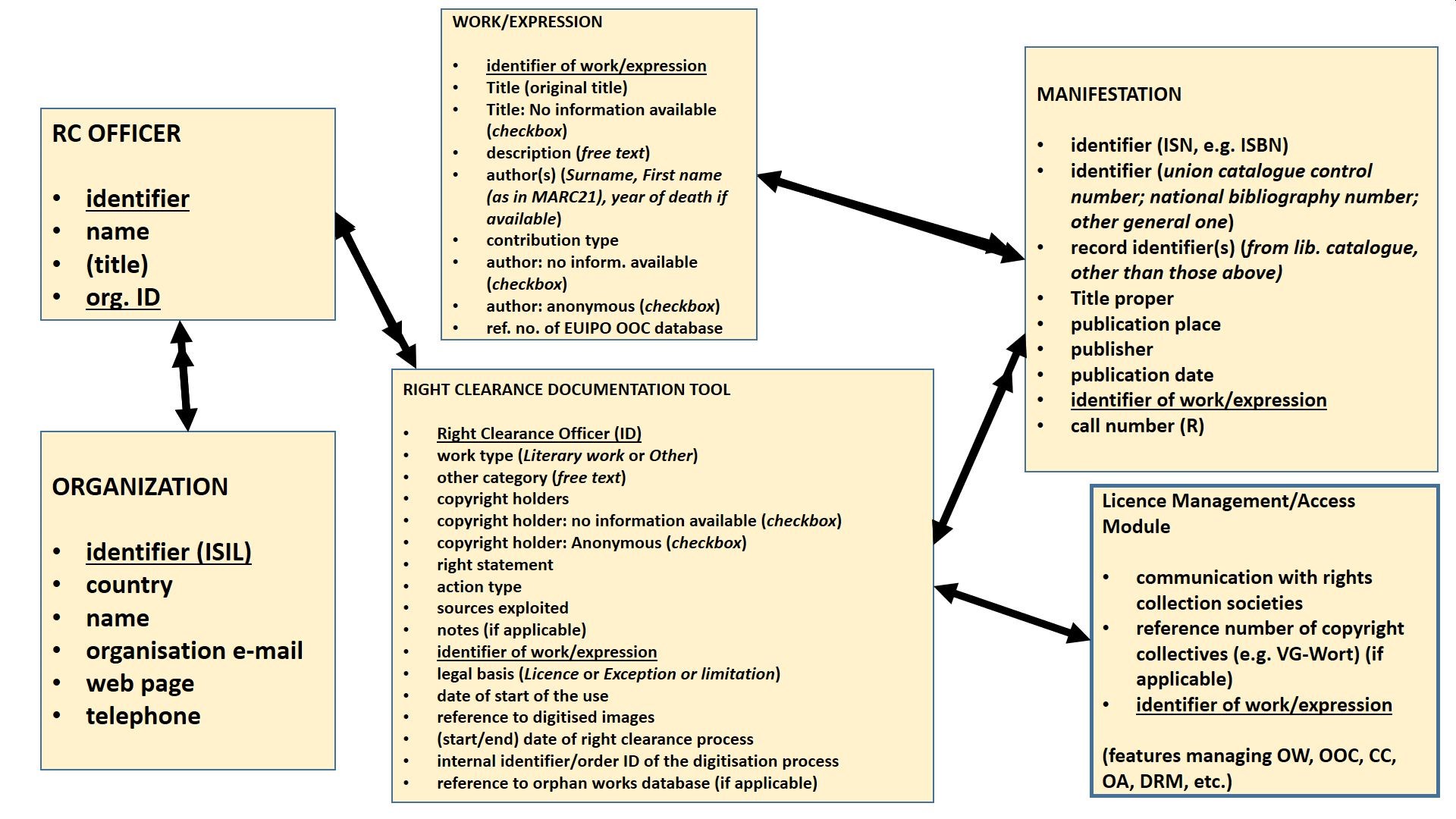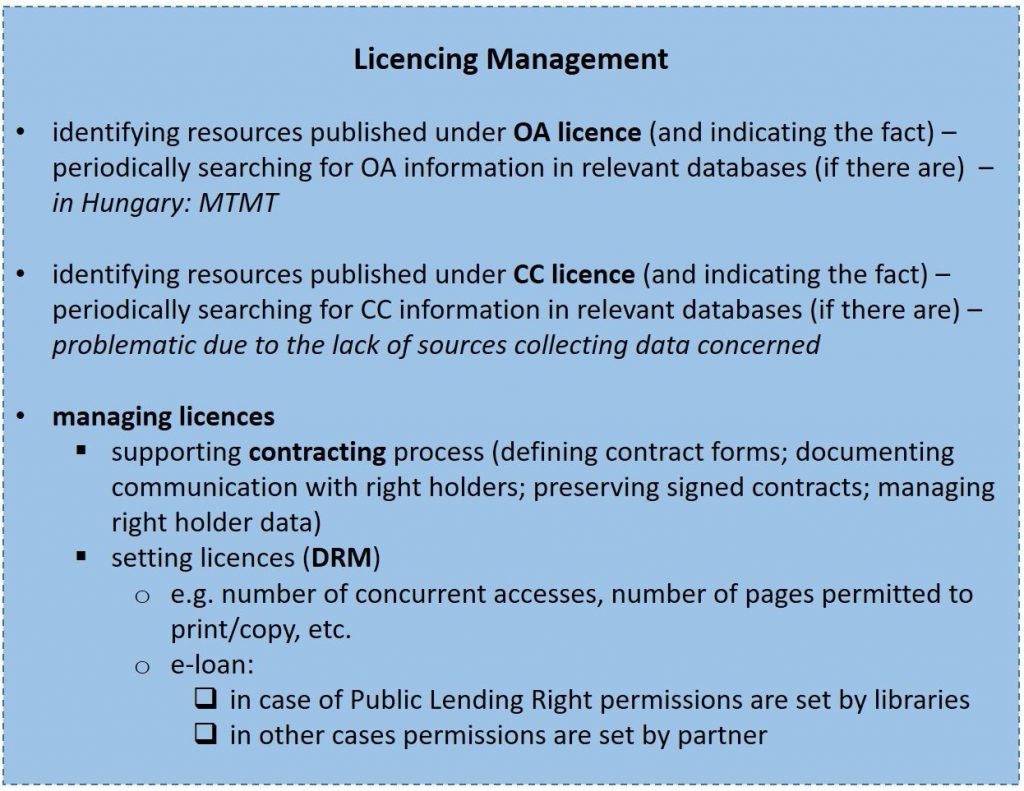NSZL participates in the tasks of all working groups. Its main task is to design and develop a copyright clearance documentation tool within its working group (WG6) that simultaneously fits the national library’s own systems and takes into account the interoperability requirements of partner institutions.
WG6 TASKS
CONTRIBUTION TO THE TASKS OF OTHER WGS
As a part of its new library platform under development, National Széchényi Library is going to implement a specific module in order to manage accesses to the contents of its digital library. It is obvious that processes of copyright clearance need to be documented in such a module. As a result of participation in EODOPEN we redesigned our system in order to make the requirements meet with those of the Rights Clearance Documentation Tool (RCDT) that is going to be developed in the framework of the project. When designing this tool the aim of Europe-wide application, therefore a quite high level of flexibility should be taken into account.
IDENTIFYING REQUIREMENTS
A questionnaire was sent to project partners to identify requirements. We asked them about the copyright clearance workflow applied in their institution. Workflow implemented at our library was attached to the questionnaire to serve as a guideline in responding. We also asked them about the legislative background of rights clearance and the data models considered to be implemented when developing RDT. We needed to clarify as well if the system to be designed should include licence management with its full documentation (incl. contracts and emails with right holders, etc.) and registering Creative Commons licences and Open Access declarations too.

BUILDING A COMMON WORKFLOW
Responses provided by our project partners have been analysed and integrated into the common workflow of copyright clearance which is an important component of the specification under construction.
Partners mainly agreed on the metadata elements and value vocabularies to use in the documentation tool.
In the questionnaire we asked partners about the existence and feasibility of Books In Print databases in the relevant countries and we got to know that it is not a typical service in the region covered by project members. There is such a system in German-speaking countries (Verzeichnis Lieferbarer Bücher (VLB): www.vlb.de) which plays an important role in identifying and making available out-of-commerce works. The National and University Library in Slovenia also recognized the importance to establish and maintain a BiP service (Knjige v tisku: https://www.nuk.uni-lj.si/viri/knjige-v-tisku), while in Hungary a database for managing data about availability of books is just under construction (https://opusnet.hu/). A new law forced national libraries in the Czech Republic and Slovakia to develop a sort of inverse of Books In Print databases which are for maintaining data on out-of-commerce works.
OOC WORKS AS A NEW PERSPECTIVE
As far as providing legal access to digitized contents is concerned, existence and usability (e.g. queryability through standard interfaces) of Books in Print databases involving access data on in-commerce works became crucial as so called DSM directive came into force. The full title of the document is “Directive (EU) 2019/790 of the European Parliament and of the Council of 17 April 2019 on copyright and related rights in the Digital Single Market and amending Directives 96/9/EC and 2001/29/EC (https://eur-lex.europa.eu/legal-content/EN/TXT/?uri=CELEX:32019L0790). Adoption of the Directive by Member States might make copyright clearance procedures much simpler.
“Member States shall provide that a collective management organisation, in accordance with its mandates from rightholders, may conclude a non-exclusive licence for non-commercial purposes with a cultural heritage institution for the reproduction, distribution, communication to the public or making available to the public of out-of-commerce works or other subject matter that are permanently in the collection of the institution, irrespective of whether all rightholders covered by the licence have mandated the collective management organisation …” (Article 8, 1.)
At the first period of the project we were not aware of what requirements the law would specify for identification of an out-of-commerce work, but it was anticipated that the requirements would be much simpler than those applied for orphan works. The original goal of EODOPEN was to support workflow for diligent search which needs to be conducted in order to identify a work as an orphan one, this goal seems to require a reconsideration.
The following illustration shows how data of works identified as orphan by diligent search is uploaded to the database maintained by European Union Intellectual Property Office (EUIPO), how this data is registered, after being forwarded by the Hungarian Intellectual Property Office (HIPO), in the database, and how orphan works become freely accessible by beneficiary institutions such as libraries.

NSL has been cooperating with EUIPO since years in the field of technical development in order to provide interoperability between their systems. In harmony with DSM Directive, data on OOC works can be accessible through a database maintained by EUIPO. According to the OOC regime, come into force in June of 2021, a work registered in EUIPO database is allowed to make digitally available six months after its registration as out-of-commerce work. In the meantime, rightholders have the possibility to exclude their works or other subject matter from the licensing mechanism set out in the Directive without any consequences, i.e. without their work being made available by CHIs.
The schematic figure of workflows supporting e-library services according to the concept of technical implementation of OOC regime in Hungary:

Systems supporting workflows outlined above need to be flexible enough in order to help stakeholders in exercising their interests in an effective way, whether they are rightholders wanting to track the distribution of their works, or content providers focusing on the credibility and promptness of copyright clearance. As a conclusion, both systems maintained by EUIPO and solutions developed in the framework of EODOPEN project need to be interoperable in the sense of the metadata schemes and interfaces for data exchange they apply.
When specifying data elements for Right Clearance Documentation Tool (RCDT), beyond partners’ requirements compliance with EUIPO database also needs to be taken into account in order to facilitate bulk import and export of data on resources already undergone through copyright clearance. Another aspect of high importance can be the possibility of data synchronization with Books in Print databases.
The conception can be realized via different schemas, the one outlined below illustrates only one of the options.

Developing a licence management system needs a deeper elaboration, including clarification of concepts by different project partners.

CONCLUSION
As a conclusion, we might add that by the current period of the project we can clearly see the direction of developments which need to be refined according to current changes of national copyright laws (mainly due to the adoption of DSM Directive), and the situation implied by new national digitization projects.
Necessary cookies are absolutely essential for the website to function properly. This category only includes cookies that ensures basic functionalities and security features of the website. These cookies do not store any personal information.
Any cookies that may not be particularly necessary for the website to function and is used specifically to collect user personal data via analytics, ads, other embedded contents are termed as non-necessary cookies. It is mandatory to procure user consent prior to running these cookies on your website.